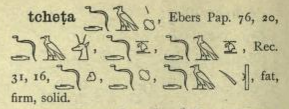RESTART
themes: eden-lampstand as ram
goat as matrix lampstand [same archetype as behemoth]
raising of the DJED-pillar, as the abomination of desolation
nowhere is written ‘daily sacrifice’ —– is a Lie
textnote:
we are aware that often people read words at face-value, and many think a term as “the land” should be ofcourse “this earth, we live on” — but a term like this is decided from the context it is placed in; for example, “Egypt” is a real country during the exodus, but always represents Sekhet-Áaru when the term is used in prophecy. Related to this face-value is a second problem, namely the line-up of the words being used:
there is the “interlinear version” (which we use), and there is the other version (from which most modern versions are taken from, as KJV); but this version is often “switching words” in a sentence, and when object and subject have switched places, it often renders a different meaning, altogether. We consider this was done on purpose, in order to “keep the adamite soul thinking like Job”, using “sorcery by words”: because sorcery is typically about “creating another consciousness by hustling the order of words”; and we consider the added term as “reverse interlinear” to be no accident.
note: our interpretation of the line in purple; possible interesting terms for you in the notes in darkblue ; we apologize for each time the extensive notes, it makes things very unreadable, but Vital for context; we added other (legal) possible readings in red , glued to objectword,
|
Daniel 8
starting at line three – the Ram as eden’s lampstand –
3
and·I-am-lifting eyes-of·me and·I-am-seeing and·behold! ram one standing to·faces-of the·canal and·to·him two-horns and·the·two-horns lofty-ones and·the·one lofty from the·second and·the·lofty-one coming-up in·the·last Then I lifted up mine eyes, and saw, and, behold, there stood before the river a ram which had [two] horns: and the [two] horns [were] high; but one [was] higher than the other, and the higher came up last |
 |
|
 |
- KHENUM, to right: strictly speaking, this ram-god-potter is one of the earliest gods of their pantheon; the “flat-horned ram species” is now extinct (symbolism on purpose), the sitting deity in the pic; perhaps elevant as the KH-, which we saw relates to their pre-eden-land way south (Job 38 page); the sigil in lower-right corner, the KA-spirit-double projected upon the djed (as fourfold) can relate to the build-up of the lampstand — as core-pole with two main side-arms (horns), (the two arms of the KA- as the two arms of the lampstand; similar as double-horn UP- ), and his “flat horns” because of the “horizontal direction of Eden’s dimension”,
- since Heaven never tricks, this Ram may depict the difference between “dimensional background VS dimensional foreground”, as well — compare glyph H’A and H’AT; in either case, it appears to have been very vulnerable against the nature of dualism – as the West,
context: it shows already a difference within the eden-lampstand: the one main-arm (from centrepole) is different as the other one (but it doesn’t say which one); for us important because of the theme in spells as “the western and eastern shoulder”, of which one with magically-dangerous doubleslash \\, as “shoulder of Saturn QÃH’ ” theme;
“and I am lifting up / my eyes / and I am seeing / and look!. / one – ram / standing (firmly) / in front of / the conveyor (Watercourse), / and toon him / two horns (trumpets), / and the two horns / (as) lofty ones on-high, / and the one / lofty on-high / from / the second (one) / and the lofty one on-high / coming up / inas the last,”
I-saw the·ram rushing-forth sea·ward and·north·ward and·southland·ward and·any-of animals not they-are-standing to·faces-of·him and·there-is-no one-crescuing from·hand-of·him and·he-did as·approval-of·him and·he-magnified-himself
I saw the ram pushing westward, and northward, and southward; so that no beasts might stand before him, neither [was there any] that could deliver out of his hand; but he did according to his will, and became great
- ‘pushing forth’; as root; depicting the Eden realm coming into being, pushing back théir dualism-realm; note how Heaven is east, so he don’t need to push towards there,
- ‘beasts’, H2415, “living, life (breathing), “beast” only by extension, can also be man; since we are here at the beginning, we can use “beings” – because who knows what roamed, backthen; and juxtaposed against this ram-construct, they may be “other constructs” (there is a chapter somewhere called “against the beasts of the south” — but we still need to see what are those),
“I saw / the ram / pushing-forth / dimension-ward (west) / and inaccessible-ward (north) / and southland-ward, / and any of / living creatures / nót / they are standing firm / in front of him, / and there is no / one rescuing(taking-away) / fromof his hand (sic), / and he did / as according to his pleasure / and he magnified himself,”
5
and·I I-became considering and·behold! he-goat-of the·goats coming from the·west over surfaces-of all-of the·earth and·there-is-no one-touching in·the·earth and·the·he-goat horn-of conspicuous between eyes-of·him
And as I was considering, behold, an he goat came from the west on the face of the whole earth, and touched not the ground: and the goat [had] a notable horn between his eyes
- ‘goat’, H6852, no root; yet not as -az (azaz), so why tzephyr..? greek Zephyr as “west-wind” root zfr linked to Zippora (wife of Moses), no Akk. link; greek deity Zephyros as west-wind blew the disk away (as áten disk); and though ÁMENT is the glyph for “the west”, the MEN- derives from SEN-, so this term cannot relate to their original west; so the whole theme of “the west” remains a bit Vague,
- if you notice the (Ezekiel-) temple setup, the West is totally blocked –
- all Henoch mentions about “the western quarter”, i that “there is a light, pursuing all other lights of heaven”, but he don’t specify further,
pic right: “the ram / (by) to make the speech (via ad.soul)”, note also “title of Osiris” (see SAR, later on), and “to become the great pillar / (by) to make speech (via ad.soul)”, the Seti I tomb one, pic below that: “giraffe”,occasionally used in spells as “to direct” (but ‘to direct to make speech’); the “long-neck-theme” not onlydepicting the “growing abóve the eden-lampstand” but also as Anakim, the giants, “long-necked-ones”; below position, “the Watercourse \\ (for) to make eden-speech”, with magically-dangerous-\\;
|
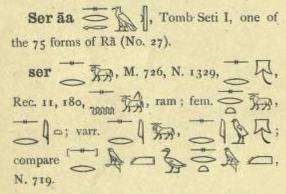
|
- ‘west’ H6148, perhaps “to barter, negotiate, trade” as colour; the word ‘arab (as in the peoples); but “trading” as in metaphysical sense; Akk. erêbu, “to enter, to bring (in)”, main root, “to mix, mixture” as secondary,
- ‘no one touching’, object a bit Unclear; as “nothing”? like some penetrating fog?
- ‘Sight’, our colour as combined “vision, see, behold” from rootword; used often in spells, as MAA-, as ‘universal Sight’ or “dimensional Sight”, (compare the vedic deity-title “auspicious one”, of krshna Osiris),
- 1) the “between his eyes” indicates “brow-consciousness” (blue chakra-type) of matrix Sight/calculation/creation, line,
“and I was considering, / and look!, / he the West-wind as the main-he-goat of / the (Ba-soul) goats, / coming / from / the West / over / surfaces of / all of / the earth (south), / and there is no / one touching / the earth, / and the main-he-goat / (has) the horn of / Sight / between / his – eyes,”
and·he-is-coming unto the·ram possessor-of the·two-horns which I-saw standing to·faces-of the·canal and·he-is-running to·him in·fury-of vigor-of·him
And he came to the ram that had [two] horns, which I had seen standing before the river, and ran unto him in the fury of his power
- ‘had (possessor of)’; strange term H1167 ba’al (baal deity); “lord, master, possessor, owner”, the glyphs have a BAAR (since they don’t use the -l) but as context unclear because an imported theme; the colour seems to be “a confederacy”, as of certain aspects; personified as “ba’al”, therefore prone to be ruled by the matrix (who is always in the centre, ruling both sides);
2) making again the case that “the first eden-lampstand needed to be mirroring the matrix’ good-and-evil”, - ‘two’, it doesn’t say “two”, the term is just “multiple”, this will be important, later on,
note: though added ‘reversed interlinear’, this verse is by accident following interlinear,
“and he is approaching / towards / the ram / (as) the confederate of / the horns / which / I saw / standing (firm) / in front of / the canal, / and he is running / to him / in with the fury of / his power,”
7
and·I-saw·him attaining side-of the·ram and·he-is-being-embittered to·him and·he-is-smiting the·ram and·he-is-breaking two-of horns-of·him and·not he-was vigor in·the·ram to·to-stand-of to·faces-of·him and·he-is-flinging·him earth·ward and·he-is-tramping·him and·not he-was one-rescuing to·the·ram from·hand-of·him
And I saw him come close unto the ram, and he was moved with choler against him, and smote the ram, and brake his two horns: and there was no power in the ram to stand before him, but he cast him down to the ground, and stamped upon him: and there was none that could deliver the ram out of his hand
H4843 “bitterness”, root-mRR, Ugar. “bless, strengthen, poison”, Akk. “myrrh”, mR-roots as “complete male, lord, master”; the myrrh as masculine-rule of willpower, glyph ÃNTiu,
- ‘brake’, as shab-, context always Watercourse-related;
- ‘two horns’ as “two shoulders of the lampstand” here, done by glyph NEM-, “to dissect”, that is, “to cut off the limbs of the enemy”; as NEMMT, ‘slaughterhouse” (into 4 nemes-jars);
- ‘rescue’, all fine, but the extra clue “hand of him” must be checked; the word H5337 is not the same colour as the H of “salvation, rescue”, but has as colour “to draw out, pull out, take away”, where the term is coloured as “and delivered me from the sword” but from “take-away fom me the sword”,
last part of line:
trivial: as in line 4, the romantic description “no-one will steal it from my hand” is próbable, but considered the crucial importance of the ‘hand’ (as executive region) improbable, in prophecy; Please compare both lines 4 and 7, knowing they “were after the hánds”; and see context of both verses,
“and I saw him / touch (merge with) / the (west-) side of / the ram, / and he is being bitter-myrrhed / toby he (the ram), / and he is smiting / the ram, / and he is breaking / both of – horns of him (lampstand-arms), / and nót / he was / strong / inas the ram / to stand firm of / the sides of him, / and(but) he (goat) is flinging it / earth-ward (south), and he is trampling it, / and(but) not / he was / the one rescuing(taking away) / toof the ram / from hand of him,”
—— end 1
8
and·he-goat-of the·goats he-magnified-himself unto exceedingly and·as·to-be-staunch-of·him she-was-broken the·horn the·great and·they-are-coming-up conspicuous four instead-of·her to·four-of winds-of the·heavens
Therefore the he goat waxed very great: and when he was strong, the great horn was broken; and for it came up four notable ones toward the four winds of heaven
- ‘waxed’, H81 as root, “fire-stick”, glyph TCHA-, “fire-drill”; the term for “very, exceedingly” is merged in H3966, 168X, but is never used in eden-context (save few corrupted examples),
- ‘the four winds’ implies an Inversal of the cardinal directions, as well (the 4 horus-sons),
- ‘spiritual breath’, see cardinal directions,
- ‘mixed-dimensions´; as “heavens”, when 1 type realm then usually as “sea”,
note: ‘the great horn’ as the horn of the Lyre; the word “break” is Watercourse-related, note the “her”;
then start to grow the 4 horns ÃB- making the Torus, above the cube,
line,
“and the west-wind he-goat of / the (Ba-soul-) goats / he magnified himself as the fire-stick / unto / exceedingly, / and as to break of him / she was broken / the horn (Lyre), / the lofty one on-high (of former ram), / and they are ascending / (as) the Sight / the four / instead of her / toas the four of / the (spiritual breath-) directions offor / the mixed-dimensions,”
and·from the·one from·them he-came-forth horn one from·inferior and·she-is-growing-great exuberance to the·southland and·to the·sunrise and·to the·stateliness
And out of one of them came forth a little horn, which waxed exceeding great, toward the south, and toward the east, and toward the pleasant [land]
|
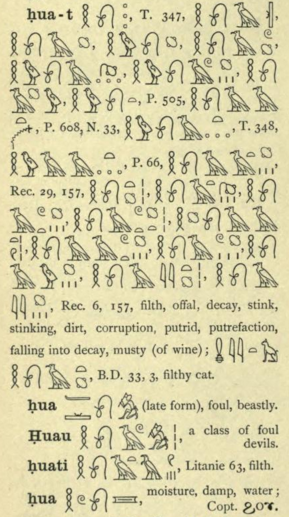 |
- waxed’, but as root “to twist, twist together, wind”, as the saturn lamp-wich glyph H’, to right, as twisted-cord; note how it now becomes a “she”; the saturn-wick as the split-off Watercourse (twisted with a part of her, that is), with “the Vintage (adamite originals) atóp of the split-off Watercourse”,
glyph pic –the ‘foulness’ as “the essence / (by) the imprisoned Watercourse word / (for,of) the saturn-wick”; below that, H’uau, not as “class of foul devils”, but the endglyph means ‘magically-dangerous concept ‘: as “the words / (of) vulture-rule / (as) the imprisoned word of the Watercourse / (of,for) the saturn-wick”, and the last position, with pool-glyph “moisture, damp” speaks for itself, - ‘great (exuberance)’; we had that strange “ones who remain”, and we showed the NTT-glyph (other page), line here that “the dualistic-wick is ment to feed those-who-are”, not growing great for the sake of itself,
- ‘eastern-land’, H4217, see main-diagram, as ÁABT-glyph,”eastern-land” of the “two-lands concept”, because the term for “the East as Heaven” is anóther strong ‘s number,
- ‘pleasant [land] (stateliness)’; H6643, but a Concept; we found Akk. zebû, “slaughter”, zebh, “sacrifice”, phoenician zbh, and Ug. dbh of the same meanings; per context it is automatically glyph ÁMENT, or “the west-land”; as the listed usages show: Dan.11, “the north king”, is “pitching his tent on Áment’s holy mountain (the north one)”, making this king of the north to represent “the rule of the north mountain” (diagram). Seen like this, all of what the north-king is doing (in Dan.11) makes sense – but Devious is the (rabbinic) suggestion that “pleasant[land]” points to ‘current israel’ (see entry), as if it is “the mountain of holy beauty, used of mt.Zion” (id.) — luciferian Nonsense. That often this H6643 is termed as “roebuck” is from the gazelle-head now at the upper node (see vignette in the opening of mouth pages), as glyph GEH’ES, saturn-wick-H’, or even as HA- in book of gates, with hebrew-H, in the top of Osiris’ judgement hall. The question of east- and west-land we addressed elsewhere; and perhaps the only ‘positive aspect’ which the west-land has, is related to….. ‘physical reality of environment’ (?), for utter lack of other term.
note: yes we need to get used, as well, to a new line as this, having heared for ages “the little horn and big horn” etc –
line,
“and from / the one / from them (the four) / he came forth / the horn / the one / fromas the Vintage (binding-up all-those), / and she the twisted-cord (saturn-wick) is growing great / ‘those who are’ (horus-falcons) / to / the south-land (as matrix), / and (this) toas / the sunrise (the eastern-land), / and to / the western-land (Áment-slaughterhouse),”
10
and·she-is-growing-great unto host-of the·heavens and·she-is-casting-down earth·ward from the·host and·from the·stars and·she-is-tramping·them
And it waxed great, [even] to the host of heaven; and it cast down [some] of the host and of the stars to the ground, and stamped upon them
- ‘causing to fall-down’, nphl, into “nephilim”,
- ‘host’, H6635, “army, army or group of angels”; we’d say as colour “a general construct”,
host: compare our term for “a company hosting internet sites”; or “containing all the blueprints of creation” like he lampstand, tile, Vine, etc; compare Gen.2, “then the heavens and the earth were finished, and all the hosts of them”; in all prophets is frequently the title “Lord of hosts”, and though ofcourse the congregation of angels can be ment, and “blueprints” is not very romantic, it but may just be the intended phrase. - ‘trampled’, the crucial word here is “she”, the goat is still a “he”, but no core of the goat is given yet (as ‘fire’, which is a ‘she’); which means the “she” is “the the aspects of the Watercourse”
“and she the twisted-cord is growing great (saturn-wick) / onto / the host (-construct) ofas / the mixed-dimensions, / and she is (causing to) fall-down / earth-ward (south) / from / the host (-construct) / the stars (aspects) /, and she (!) is being trampled,”
11
and·unto chief-of the·host he-magnified-himself and·from·him he-cheaved he-was-cheaved the·continually and·he-was-flung-down site-of sanctuary-of·him
Yea, he magnified [himself] even to the prince of the host, and by him the daily [sacrifice] was taken away, and the place of his sanctuary was cast down
|
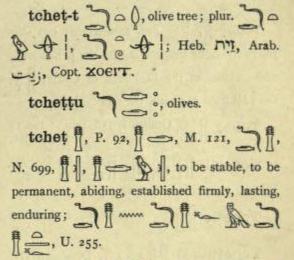
|
- and the same time, we are also angry with oursélves that we did not read this before…. but since we do now, the power of Esau’s Lie has vanished, concerning this theme; it was our mistake, as adamites, to let Esau translate: we have let the fox guard the henhouse.
glyph pic: TCHET’, “permanent, stability, etc”; “the pillar / (as?) the hand / (of) the serpent-hand”; we’re carefully trying to grasp this djed-thing, complex as it is; in several spells ‘stepdowns’ are said about this djed, from TCHET’T’I to TCHET’T to TCHET’, but now we know whére it is placed (see next line 12) we may start seeing some logic in the causal reasoning; that it is also ‘olive’ (top position) is not necessarily true — it may be the “fig tree” strong’s H8384 tê’en; (entry: ‘perhaps of foreign derivation’); perhaps the event in the NT where He is “cursing the fig tree” just *may* be representing the Djed; and does Gen.3 help us, “they made aprons for themselves from fig tree leaves”..? Why the fig?
glyph pic 2: for context, TCHET’A, “firm, solid”, you see few ram’s heads, also one gazelle
(the gazelle-head placed upon the pillar, as copied countenance); also twice as “the essence /…”, and once “to become the tail / (for) vulture-rule…” (for us important to get ‘the tail’, SET’; the set-animal always pictured with upright-tail, where the animal is the tile-stone; and later in this chapter the Self appears as TCHES, serpent-TCH + adamite-soul-S ); - ‘upwards’, we added the word, for reason that we suspect that the djed-pillar “stands upon the eden-tile”, not “standing upon the land, south”,
- ‘the place’; H4349 “fixed place, foundation, settled place (always of IEUE or eden)”, from root H3559 kün “stability, to be established, to fix, prepare, be ready, be certain, etc”; often in context of “having created, to fashion”; in virtually every instance related to eden; this aspect is important, because the Djed has taken exact this aspect of “stability”,
- ‘sanctuary’, qdsh, always eden’s; here Miy-qdsh, see Michael, previously; making us question whether indeed the -M is related to the “north-realm of rule” (compare hebrew “maqqel axis”),
“and unto / the (matrix-) prince of / the host (-construct) / he made himself into, / and from him (upwards) / he erected / he was erected / the stability (djed-pillar), / and he was flung down / eden’s foundation-place ofas / he the sanctuary, ”
12
and·host she-was-given on the·continually in·transgression and·she-is-flinging truth earth·ward and·she-did and·she-prospered
And an host was given [him] against the daily [sacrifice] by reason of transgression, and it cast down the truth to the ground; and it practised, and prospered/span>
note: it indeed appears that the Djed-pillar stands upon the tile, carrying their copied moon-eye, |
 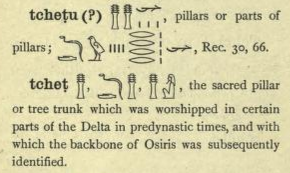 |
line,
“and the (same) host (-construct) / she was placed / up-ón / the Djed-pillar / inas the transgression, / and she is flinging / the stability (by truth) / earth-ward (south), / and she (the djed) laboured / and prospered,”
———————– end 2


